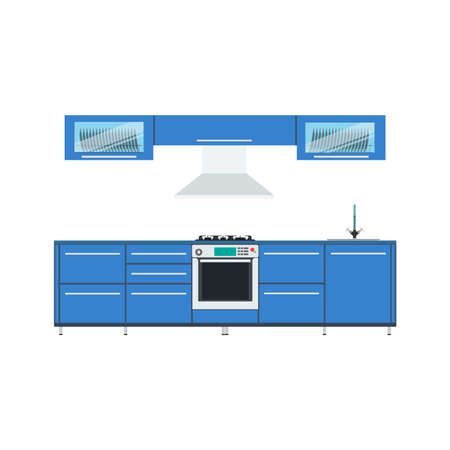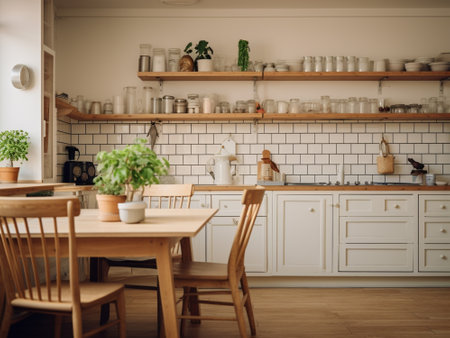Introduction to Open Kitchen Concepts
Open kitchen designs have become a staple in American homes, representing a significant shift in how we view and use our living spaces. Unlike traditional kitchens that are closed off from the rest of the home, open kitchens are designed without walls or barriers separating them from adjoining areas such as the living room or dining space. This layout encourages interaction, creates a sense of spaciousness, and allows for more natural light to flow throughout the house. Over the past several decades, open kitchen concepts have evolved to reflect changing lifestyles, values, and technological advancements. Today, they symbolize not just a design preference but also a cultural movement towards more inclusive and versatile living environments. As we embark on a historical exploration of open kitchen designs, it’s important to understand why they have become so significant—serving as both the heart of the home and a hub for family gatherings, entertaining guests, and daily life in America.
2. Early Beginnings: Kitchens Behind Closed Doors
In the early days of American households, the kitchen was a far cry from the open and inviting spaces we see today. Instead, kitchens were intentionally designed to be hidden from sight, tucked away at the back of the house or even in separate outbuildings. This separation was both practical and cultural. During the 18th and 19th centuries, kitchens were considered purely functional workspaces, reserved for food preparation, cooking, and cleaning. The heat, smells, and mess generated by cooking made it undesirable for family members or guests to linger there. As a result, social life centered around parlors and dining rooms while kitchens remained behind closed doors.
Several factors influenced these early design choices. First, many homes relied on wood-burning stoves or open hearths, which produced smoke and soot. Keeping the kitchen isolated helped prevent odors and grime from permeating living areas. Additionally, the work of cooking was often performed by household staff or women who managed domestic chores out of view from visitors. The table below highlights key characteristics of traditional kitchen layouts during this period:
Aspect |
Description |
|---|---|
Location |
Away from main living spaces; sometimes in a separate building |
Design Focus |
Functionality over aesthetics; utilitarian layout |
Access |
Limited to household staff or family members responsible for chores |
Social Role |
Not intended as a gathering place for guests or family activities |
Main Features |
Large hearths or stoves, simple worktables, basic storage solutions |
This era set the stage for how Americans viewed their kitchens—as utilitarian zones rather than social hubs. It wasn’t until later that changing lifestyles and technological advancements would pave the way for more integrated kitchen designs.

3. Cultural Shifts and the Need for Openness
In the wake of World War II, American society underwent profound transformations that would ultimately shape how homes—and kitchens—were designed. The booming post-war economy led to the rise of suburbia, with millions of new houses being built for returning veterans and their families. These homes reflected changing values, including a growing emphasis on family togetherness and informality. The traditional kitchen, once tucked away and reserved solely for meal preparation by homemakers or domestic help, began to lose its rigid boundaries. Women’s roles were evolving as more entered the workforce and sought greater participation in family life. As a result, the kitchen started to become a social hub rather than just a utilitarian space.
The influence of popular media cannot be underestimated during this era. Television shows like “Leave It to Beaver” and advertisements from appliance companies showcased open-plan living, promoting a vision of households where cooking, dining, and entertaining overlapped seamlessly. Architects and builders responded by designing homes with fewer walls and more integrated living spaces. The emergence of the “great room”—a large, open area combining kitchen, dining, and living functions—epitomized this trend toward openness.
Architecturally, innovations such as steel beams allowed for larger spans without supporting walls, while new materials made it easier to create flexible floor plans. The modernist movement championed simplicity, functionality, and transparency—qualities that encouraged visual connections between different parts of the home. All these cultural and architectural shifts converged to lay the foundation for the open kitchen designs we recognize today, fundamentally altering how Americans cook, eat, and interact within their homes.
4. Rise of the Open Kitchen in Mid-Century America
The 1950s and 1960s marked a transformative era for American homes, with the open kitchen design gaining momentum as a symbol of modern living. This period was characterized by rapid technological advancements, shifting social norms, and a newfound emphasis on entertaining at home. The traditional closed-off kitchen began to give way to open layouts that seamlessly connected cooking spaces with dining and living areas, reflecting both practical needs and cultural aspirations.
Technological Innovations Drive Change
Post-war America saw a boom in new household appliances—refrigerators, dishwashers, and electric ovens became more affordable and accessible. These innovations not only made cooking easier but also allowed kitchens to be cleaner, quieter, and less reliant on heavy manual labor. As a result, the kitchen was no longer a space to be hidden away but could now take center stage within the home.
Shifting Lifestyles and Social Dynamics
The rise of suburban living brought about changes in daily routines and family interactions. With more women entering the workforce and families spending time together at home, there was a growing desire for multifunctional spaces. Open kitchens allowed parents to supervise children or engage with guests while preparing meals, breaking down the barriers between work and leisure.
Emphasis on Entertaining Guests
Mid-century American culture placed a premium on hospitality and casual gatherings. The open kitchen became an extension of the living room—a place where hosts could cook, serve drinks, and socialize without leaving their guests behind. This focus on togetherness was further reinforced by popular media, which showcased stylish open-plan homes as the epitome of contemporary life.
Key Factors Behind the Open Kitchen Trend
| Factor | Description |
|---|---|
| Technological Advances | Innovative appliances enabled cleaner, quieter, and more efficient kitchens suitable for open layouts. |
| Lifestyle Changes | Busier families needed flexible spaces that supported multitasking and togetherness. |
| Cultural Shift Toward Entertaining | Kitchens became social hubs for hosting friends and family gatherings. |
Conclusion: A Foundation for Modern Living
The mid-century embrace of open kitchen designs laid the groundwork for today’s integrated living spaces. By blending technology, lifestyle shifts, and cultural trends, these designs redefined what it meant to gather, cook, and connect in the American home.
5. Modern Innovations and Trends
Today’s open kitchen designs are a testament to how far this concept has evolved, reflecting both technological advancement and shifting American lifestyles. One of the most defining features is the kitchen island, which serves multiple purposes—from food prep and casual dining to acting as a gathering hub for family and friends. Kitchen islands often incorporate built-in sinks, dishwashers, and extra storage, making them an essential element in modern open layouts.
Integrated dining spaces are another hallmark of contemporary open kitchens. Rather than separating the kitchen from the dining area, today’s homes blend these zones seamlessly, encouraging interaction and socializing during meal preparation. This integration makes hosting easier and aligns with the growing preference for informal, communal living spaces seen across American homes.
Smart appliances have also revolutionized the open kitchen. From refrigerators that can help you manage grocery lists to ovens controlled by smartphone apps, technology now plays a crucial role in enhancing convenience and efficiency. Many kitchens feature touchless faucets, induction cooktops, and built-in charging stations, catering to the fast-paced lifestyle of modern families.
These innovations reflect ongoing efforts to create kitchens that are not just practical but also central to daily life—places where cooking, entertaining, and connecting happen effortlessly. The evolution of open kitchen designs continues as new trends emerge, always aiming to make this vital space more functional, welcoming, and reflective of American values.
6. Pros, Cons, and Cultural Impact
Open kitchen designs have dramatically transformed the way Americans experience home life, offering a blend of practicality and cultural significance.
Advantages of Open Kitchen Designs
One of the most celebrated benefits is the sense of connectivity. Open kitchens allow for seamless interaction between family members and guests, making it easier to entertain or supervise children while preparing meals. The increased flow of natural light and an expansive visual field often make homes feel larger and more welcoming. Additionally, open layouts can enhance real estate value by appealing to buyers who prioritize modern, social living spaces.
Drawbacks and Challenges
Despite their popularity, open kitchens aren’t without flaws. The lack of walls means less privacy and noise control; sounds from appliances and conversations easily travel throughout the home. Cooking smells can permeate living areas, which some find unpleasant. Furthermore, maintaining a tidy appearance becomes essential since the kitchen is always on display—clutter or unfinished dishes are visible from most vantage points.
Cultural Shifts in American Homes
The open kitchen has had a profound impact on American family dynamics. It has helped shift meal preparation from a solitary task to a shared experience, fostering togetherness and collaboration among household members. Social gatherings have also evolved; hosts can interact with guests while cooking, reinforcing the kitchen’s role as the true heart of the home.
Broader Social Implications
This design trend mirrors broader societal changes toward informality and inclusivity in American culture. As formal dining rooms become less common, the kitchen-living space blurs traditional boundaries, reflecting changing attitudes about hospitality and family life. While not without its drawbacks, the open kitchen continues to shape how Americans cook, connect, and celebrate at home.
7. The Future of Open Kitchen Design
Looking ahead, the open kitchen concept in American homes is poised for further transformation as lifestyles, technology, and design preferences continue to evolve. One emerging trend is the integration of smart home technology into kitchen spaces, with appliances, lighting, and even cabinetry becoming more connected and responsive to user needs. Voice-activated assistants, touchless faucets, and app-controlled ovens are just the beginning of a new era where convenience and efficiency play leading roles.
Another direction gaining momentum is the blending of indoor and outdoor living spaces. Homeowners are increasingly seeking seamless transitions between kitchens and outdoor entertaining areas through features like retractable glass walls, covered patios, and fully equipped outdoor kitchens. This evolution supports the American love for hosting gatherings and enjoying meals al fresco while maintaining the centrality of the kitchen.
Sustainability is also shaping the future of open kitchen design. Eco-friendly materials, energy-efficient appliances, and recycling systems are becoming standard as more Americans prioritize environmental responsibility in their homes. Designers are experimenting with reclaimed wood, recycled metals, and low-VOC finishes to create beautiful yet sustainable kitchens.
Additionally, there is a growing desire for flexible spaces that can easily adapt to different uses throughout the day. Modular islands on casters, movable partitions, and multi-purpose cabinetry allow homeowners to reconfigure their open kitchens for cooking, working from home, or entertaining guests as needed.
Personalization will likely remain a key theme in future designs. With an abundance of finishes, layouts, and smart features to choose from, homeowners can create open kitchens that reflect their unique tastes and lifestyles while remaining functional and inviting.
In summary, the open kitchen concept continues to capture the imagination of American homeowners by fostering connection and versatility. As technological advancements meet evolving cultural values around sustainability and flexibility, we can expect open kitchens to remain at the heart of American home life—adapting in innovative ways to meet the changing needs of families for generations to come.

